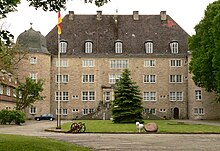Neumühle Castle
Neumühle Castle is a castle in the Neumühle district of the Beetzendorf municipality in Saxony-Anhalt . It is the youngest new palace in Germany and belonged to the Wolfsburg line of the von der Schulenburg family . The name "Neumühle" is based on the name of the district that lies between Mellin and Tangeln .
Building description
The castle is almost as big as Wolfsburg Castle. In the west is the main house in west-northwest-east-southeast direction. This is followed by a flatter, long building towards the north-northeast. Two more flat wings are at right angles to it. To the east of the two wings is another large house. The main house has four round corner towers and five floors.
The castle is on a hill. It is surrounded by spacious gardens and is located in a forest so that it cannot be seen from a distance.
history
In 1938 the city of the KdF-Wagons - today's Wolfsburg - was founded by the National Socialist rulers. The Wolfsburg Castle located there , which belonged to Günther Graf von der Schulenburg-Wolfsburg , was expropriated. The von der Schulenburgs received 560,000 Reichsmarks and from 1938 built a new castle on a forest property they owned in the former municipality of Tangeln in the Altmark , around 35 kilometers from Wolfsburg Castle. It was built according to plans by the architect Paul Bonatz using reinforced concrete , a modern construction method at the time . Construction was completed in 1942; it was moved into in November of the same year. Outwardly it resembles Wolfsburg Castle, which was built primarily in the Weser Renaissance style.
In 1943, parts of the extensive collection of the Kunsthalle Bremen were brought to the palace to protect them from war damage caused by the air raids on Bremen during the Second World War . In the early summer of 1944, Ursula Countess von der Schulenburg hid the family treasure inside the castle. It consisted of jewelry, family silver and porcelain as well as the correspondence between Friedrich the Great and Gebhard Werner Graf von der Schulenburg , especially from 1776 and 1777.
Towards the end of the war, in April 1945, US soldiers first reached the castle. They were able to secure a large part of the Bremen paintings and have them returned. Until May 11, 1945, they used the castle temporarily as a division headquarters. After the British occupation forces took over the castle for a few weeks, Soviet soldiers followed in June. From July 1, 1945 it was part of the Soviet occupation zone . Shortly before the establishment of the Soviet occupation zone, those of the Schulenburg fled back to the vicinity of Wolfsburg and settled on the Nordsteimke manor . In doing so, they left most of their belongings behind. The castle was looted by Red Army soldiers , but the family treasure was not found.
The aristocratic archives from the former Wolfsburg Castle were also kept in the castle. Large parts of the aristocratic archives were destroyed by the Soviet occupying forces. In 2007, a project to document the whereabouts of the archival material was started, the result of which was a CD entitled "Sources on the history of Wolfsburg Castle and the von Bartensleben and von der Schulenburg families".
The von der Schulenburgs were again expropriated and no longer had access to Neumühle Castle. After the war, refugees were housed there; it was then converted into a sanatorium for those suffering from pulmonary tuberculosis . From 1965 to 1991 the castle was used as a nursing home for the mentally handicapped. After the fall of the Berlin Wall , the von der Schulenburgs did not get the castle back in accordance with the two-plus-four contract . In 1993 a Hamburg company set up a senior citizens' home there, in which mentally and mentally handicapped people were looked after. In 1997 the home continued to exist; however, the company planned to move to a home in Beetzendorf.
In autumn 2001, the family treasure hidden in 1944 was rediscovered by a private person in a double wall next to the Count's former study and handed over to the descendants.
The castle has belonged to a Hamburg real estate agent since March 2000 and is not open to the public.
literature
- Dietrich Werner Graf von der Schulenburg, Hans Wätjen: History of the sex from the Schulenburg 1237 to 1983. Lower Saxony printing and publishing house Günter Hempel Wolfsburg, ISBN 3-87327-000-5 , Wolfsburg 1984, pp. 390-391.
- Eberhard Rohde: Secret in the "new" Wolfsburg. In: Wolfsburger Nachrichten. Issue No. 159/2016 of July 9, 2016, p. 14.
Web links
- Correspondence found again at Neumühle Castle
- Report on the castle in the taz from October 9, 2012
Individual evidence
- ^ Altmarkgeschichte ( Memento from September 11, 2012 in the Internet Archive ), accessed on September 9, 2014
- ^ Bonatz 'biography on the website of the University of Magdeburg , accessed on October 6, 2012
- ^ Official website of the Kunsthalle Bremen , accessed on October 16, 2011
- ↑ Interview with contemporary witnesses , accessed on October 16, 2011
- ↑ Martin Stöber: Castle history without sources? The digital finding aid on the history of Wolfsburg and the von Bartensleben and von der Schulenburg families (= Archive News Lower Saxony . Volume 12/2008 ). 2008, ZDB -ID 2139298-5 , p. 41 ( vna-online.de [PDF; 9.9 MB ; accessed on April 26, 2020]).
- ^ Report on the castle in the taz of October 9, 2012
- ↑ Caritas article from 1997 , accessed on August 29, 2011
- ↑ report at musenblaetter.de , accessed on February 3, 2016
- ^ Article in the Altmark Zeitung of February 16, 2011 , accessed March 7, 2012
Coordinates: 52 ° 39 ′ 27 ″ N , 11 ° 0 ′ 13 ″ E
